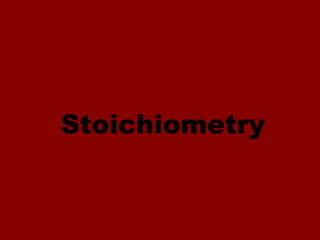
Stoichiometry for online
- 2. Stoichiometry is the study of quantitative relationships in chemical reactions.
- 3. The basic idea used in solving stoichiometric problems is the mole concept.
- 5. Molecular weight is the sum of the atomic weights of all the atoms in a molecule. A molecule is the smallest unit of a covalent compound.
- 6. What is a mole?
- 7. A mole (mol) is a SI base unit used to measure the amount of material in a chemical sample.
- 8. 1 mole of H2O contains 6.022 x 1023 H2O molecules (Avogadro’s number)
- 9. A coefficient in a balanced chemical equation indicates the number of moles of a chemical compound involved in a chemical reaction. 2H2 + O2 2H2O
- 10. The coefficients give you the mole ration of the compounds involved in the reaction. 2H2 + O2 2H2O The mole ratio of hydrogen to oxygen is 2:1 (for every one oxygen put into the reaction, 2 moles of hydrogen are also needed to put into the reaction)
- 11. The unit of moles provides a “bridge” to mathematically convert between several different aspects of chemical compounds.
- 13. Moles link an abstract chemical equation to a concrete unit of measurement (grams, Liters, number of molecules)
- 14. For example: 1 mole = 6.02 x 1023 molecules 1 mole = molecular mass of a substance 1 mole = 22.4 L of a substance at STP (standard temperature and pressure)
- 15. For example: 1 mol Cl = 6.02 x 1023 molecules Cl 1 mol H2O = 6.02 x 1023 molecules H 2O 1 mol Cl = 35.45g Cl 1 mol H2O = 18.01g H2O 1 mol Cl = 22.4L Cl @ STP 1 mol H2O = 22.4L H2O @ ATP
- 16. There are several types of calculations that can be used in Stoichiometry.
- 18. Involves 1 conversion factor
- 19. The object of this type of problem is to calculate the moles of one substance when given the number of moles of different substance.
- 20. Example: Magnesium hydroxide reacts with carbonic acid. How many moles of water will be produced from 3.5 moles of magnesium hydroxide? You are given the moles of one substance and asked to find the moles of another substance.
- 21. Example: How many moles of ammonia can be produced from 8.00 moles of hydrogen reacting with nitrogen?
- 22. Example: K2Cr2O7 + 6KI + 7H2SO4 Cr2 (SO4)3 + 4K2SO4 + 3I2 + 7H2O Calculate the number of moles of potassium dichromate that will react with 2.0 moles of potassium iodide. Calculate the number of moles of iodine that will be produced from 2.0 moles of potassium iodide.
- 23. Mole – mass calculations
- 24. Involves 2 conversion factors
- 25. The object of this type of problem is to calculate the moles of one substance when given the mass of different substance. Or vise versa
- 26. Example: What mass of hydrogen can be produced by reacting 6.0 moles of aluminum with hydrochloric acid? You are given the moles of one substance and asked to find the mass of another substance.
- 27. Example: How much carbon dioxide is produced by the complete combustion of 0.0492 mol of propane, C3H8?
- 28. Example: How many moles of water will be produced from 14.6 g propane in the combustion of propane?
- 29. Mass – Mass calculations
- 30. Involves 3 conversion factors
- 31. The object of this type of problem is to calculate the mass of one substance when given the mass of different substance.
- 32. Example: How much carbon dioxide is produced by the complete combustion of 100.0 g of propane, C3H8? You are given the moles of one substance and asked to find the mass of another substance.
- 33. Example: Magnesium chloride reacts with sulfuric acid. How much sulfuric acid is needed to produce 26.3 g of magnesium sulfate?
- 34. Calculations involving Liters and number of molecules
- 35. Example: How many moles of ammonia can be produced from 1.03 Liters of hydrogen reacting with nitrogen at STP?
- 36. Example: How many carbon dioxide molecules are produced by the complete combustion of 32.00 grams of propane, C3H8?